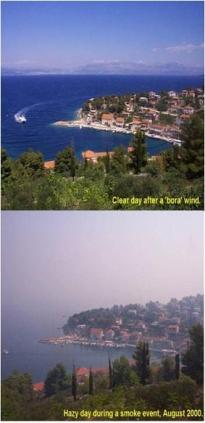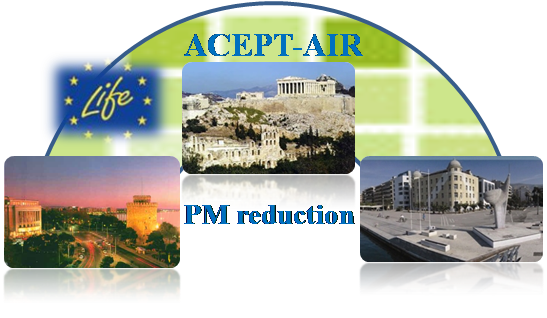|

|
|
|
| |
ACEPT-AIR |
 |
Development
of A Cost Efficient Policy Tool
for reduction of Particulate
Matter in AIR |
| |
The project aims to provide
the National Authorities at Central
Regional and Local level with
the means to control PM2.5 and PM10
concentrations in air.
Airborne Particulate
Matter (PM)
is a complex mixture of microscopic
particles derived from both anthropogenic
and natural
sources. It is still a major Environmental
problem in several countries in
the EU, while new
evidence regarding its detrimental
impact on human health has emerged.
Greece is one
country among others in the EU,
where a great deal of improvement
with respect to
emission control strategies can
be made. The proposed project is
targeting, firstly, to
unravel the relative contribution
of the multiple anthropogenic and
other sources to the
observed PM air concentrations.
Secondly it will document the relative
contribution of
secondary aerosol particles to
those from primary emissions, by
taking into account the
atmospheric processes which contribute
secondary and primary PM at any
given receptor
site.
State of the art data and models
will be incorporated in a versatile
tool which will combine
comparative analysis of source contributions
calculated from air concentrations
and
emission inventories. The tool will
create a historical record of control
measures, changes in
emissions, targeted or economy driven,
and provide results in measured concentration
reductions apportioned to changes
in every accounted source. This can
allow the policy
makers to evaluate the effects of
control measures applied on specific
emission sources as
well as plan new ones. The project
aims to demonstrate to local Regional
and National
Policy makers, the cost effectiveness
of the tool developed, as it will
be possible to evaluate
quantitatively the results of policies
on specific sources.
At present, although
a number of measures are adopted
for reduction in certain emissions
and concentration levels are generally
reduced in the last two decades,
the quantitative
result of these changes is largely
unknown with respect to each one
of the emission
sources. As the Commission of E.C.
is moving towards the implementation
of the Thematic
strategy on air Pollution, through
the most recent Directive
2008/50/EC, and
requirements of lower limit values
for PM in air will come in effect,
reduction in emissions will become
costly
and future management of emissions
will require quantitative forecasts
based on previous
results.
In addition Public awareness is needed
to be raised, so that policies can
be positively
adopted by the Public. The results
from new emission control strategies,
the application of
Green measures and new products can
be all evaluated by the proposed
Policy Tool, with
respect to their measured reduction
in PM concentration, for every one
of the sources.
These results as well as estimated
forecasts will be communicated by
an active
dissemination Programme to the citizens
and their active participation will
be promoted.
|
|
| |
It is proposed
to achieve this by the development
of an integrated tool combining:
Action 1 (Project Management): Establish
a core management committee composed
of representatives of all partners
and ensure availability of adequate
resources on their behalf for the submission
of correct financial and administrative
data (reports). The chairman will have
the general responsibility for the
organization, planning and control
of the project. Establish a steering
Committee where, apart from the partners,
main stakeholders will be involved.
Action 2: Updated
historical and current databases for
PM2.5 and PM10 concentration parameters,
for the urban areas of Athens, Thessaloniki
and Volos in Greece. Update the database
of chemical source and ambient concentration
in order to compare present and past
source profile variability.
Action 3: State of
the art source apportionment techniques
based on the developed databases and
receptor modelling. Apply state of
the art source apportionment models
available in the public domain and
incorporate them in the series of modules
required in order to develop the basis
of the policy control tool.
Action 4: Updated
emission inventories for primary anthropogenic
and natural particulate matter sources.
Action 5: An operational
platform where the modules of the previous
actions will be assembled including
databases of concentration levels of
particulate matter mass, chemical composition
of major and trace substances, emission
inventories and source apportionment
calculation module for analysis of
the results. This platform will be
developed in the form of a software
tool allowing the assessment of the
relative trends in emissions and observed
concentration levels in parallel to
the resolved contributions from the
different sources so that identification
of the results from previous control
strategies can be achieved and new
measures proposed.
Action 6: A two-way
direct interaction process enabling
the stakeholders involved to understand
and be trained in the use of the developed
policy tool concerning the reduction
of key environmental factors and their
interdependencies and to respond to
benefits and problems like particulate
matter concentrations in air in a competent
way.
Action 7: Active
application of the developed tool
by means of comparing proposed or
independently applied solutions concerning
the reduction of different emissions
and the results of reduced or enhanced
trends in measured concentrations
during the course of the project.
Action 8: Create
an open forum with key stake holders
from industry, state and local authority
policy makers and NGO’s, where the
results will be presented in order
to motivate the dialogue for reduction
in targeted emission source. An International
Conference targeting the communication
of results of this project and ongoing
developments internationally, exchange
of views with Policy makers at a
European level and beyond is also
planned.
Action 9: Environmental
Dissemination embedded in a well
defined communication
strategy makes efficient use of methods, instruments
and techniques throughout the control
of particulate matter concentrations in air and ACEPT-AIR
program life cycle. Publicize the
results through web pages, production of DVDs, seminars
for secondary education teachers.
Action 10: Monitoring
of Project progress. Setting the
procedures and rules for monitoring
project progress, reporting results
to the management committee and
taking actions for maintaining
effective progress.
Action 11: At
the final stage of the project,
the database constructed as well
as source apportionment and “ACEPT-AIR”
Policy tool results will be used
to address some of the objectives
and requirements set by Directive
2008/50/EC. A set of Guidelines
for action plan formulation will
be produced, containing specific
measures and policies in order
to attain the limit values and
concentration reductions required
by the aforementioned
Directive.
Action 12: An
“After-LIFE Communication Plan”
will include a road map of the
long term application for the proposed
Policy Tool communicated at the
project’s web site, reports and
establish long term links between
the stakeholders.
|
|
| |
Expected results
(outputs and quantified achievements):
1) Detailed physicochemical
characterization of PM in air at
three characteristic urban
areas in Greece and construction of respective databases
of PM chemical composition
2) One public software tool for source apportionment
and source profile storage and
demonstration
3) 6 Emission inventories for 3 urban areas and two
types of sources (anthropogenic
and natural)
4) One set of Guidelines for effective
action plan formulation for the
3 urban areas
5) One web page portal for the project
activities (with the LIFE logo),
and full details of
its objectives, actions, progress
and results
6) 6 seminars for secondary education
teachers
7) 1 Conference for policy makers
and NGOs
8) One Layman’s report on Actions,
Tools, Effects and Long term Benefits
from the
project in local National and European
level
9) Minimization in uncertainty of
PM sources in the urban atmospheric
Environment
10) Training of existing dedicated
staff responsible for PM monitoring
in air in using the
Policy Tool developed during the
project
11) One DVD and one pamphlet
12) Three technical publications
in Scientific journals (Atmospheric
Environment, Journal
of water air and soil pollution etc.)
13) 5 Project reports including Inception
report, progress reports, midterm
and final
reports
|
|
|
|
LIFE
09 ENV/GR/000289
ACEPT-AIR |
Programme
Life+Environment Policy and Governance |
|